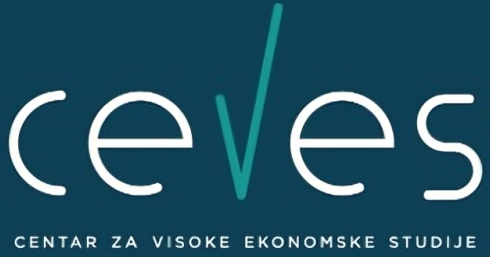Survey report is a part of of Project “Serbia’s Real Sector Performance: Exhibited Competitiveness by Size, Industry and Region” funded by USAID Sustainable Local Development Project. The goal of this survey was to assess the key factors underlying the performance of enterprises in Serbia. It covers ten general topic areas of private sector operations in attempt to broadly identify and assess what firms do, how they are structured and run, whom they interact with and how, and what their expectations are for the future. In line with CEVES’ belief that exports must be the primary mechanism underpinning Serbia’s economic growth, the survey focuses only on tradable sectors. It also hones in relatively more on three areas CEVES considers to be particularly important determinants of company success or failure: corporate governance, financial management and access to finance, and exports.
Izveštaj ankete predstavlja deo Projekta “Performansa realnog sektora u Srbiji: Otkrivena konkurentnost po veličini, sektoru i regionu”, koji je finansiran od strane USAID Projekta za održivi razvoj. Glavni cilj ove ankete jeste da se ispitaju ključni faktori, koji utiču na performanse preduzeća u Srbiji. Anketa pokriva deset opštih oblasti aktivnosti privatnog sektora, u pokušaju da se široko identifikuje i sagleda šta firme rade, kako su struktuirane i kome njima upravlja, sa kime i kako komuniciraju sa okruženjem, i kakva su njihova očekivanja u budućnosti. U skladu sa CEVES-ovim stavom da je izvoz glavni pokretački mehanizam rasta srpske privrede, anketa je fokusirana samo na razmenljive sektore. Takođe, anketa obraća više pažnju na tri oblasti, koje CEVES smatra da su od izuzetne važnosti za uspeh, tj. neuspeh firme: korporativno upravljanje, finansijsko upravljanje i pristup finansijama, i izvoz.
In the realm of corporate governance, the survey revealed that company ownership and decision-making authority tend to be concentrated in few people. Around three quarters of companies only have one owner; moreover, single individuals tend to hold ownership stakes greater than 50% in businesses with multiple individuals in the ownership structure. 90% of companies are also family-owned. Owners are most often the only individuals involved in important operational decisions such as capital investments and taking on additional credit. They are also normally the only ones involved in the regular financial management of the company.
In terms of financing, most companies rely mainly on themselves and eschew financing from commercial banks, even in spite of evidence to suggest that businesses have reason for seeking credit. Most enterprises rely on only one source of financing – internal financing – which is also the most used source of financing in the vast majority of companies. Domestic bank loans were identified as one of the three most important sources of financing by 27% of companies. Even though over half of firms have used bank loans at some point, only around one third do so currently. Most indicated that they not need loans, but would reconsider if certain factors were to change. Given Serbian firms’ tendency innovate and invest (most did so even during the crisis), desire to expand operations (nearly two thirds stated a desire to develop their business in the future), and identification of financing as a problem (it was cited as the most common obstacle to expansion of operations), it would seem that there is indeed demand for increased access to finance.
Survey evidence broadly suggests that there is potential for Serbian companies to raise export performance. Nearly all of those that do not export (around three quarters of firms in tradable sector) note that they never have exported, and just under three quarters of non-exporters do not believe that they will begin doing so in the next year. It is then perhaps unsurprising that exports on average accounted for only 9% of company sales. Encouragingly, companies that do export tend to do so for continuous periods of time. Most cite the quality of their product as their main competitive edge on foreign markets, while firms most often pointed to trouble in finding appropriate buyers as the biggest obstacle to greater exports.
Kada govorimo o korporativnom upravljanju, anketa nam pokazuje da vlasništvo preduzeća i tim koji donosi važne odluke o preduzeću, čini svega nekoliko ljudi. Oko tri četvrtine kompanija ima samo jednog vlasnika; šta više, pojedinci čine udeo u vlasništvu veći od 50%. 90% kompanija upravljaju porodice. Vlasnici su često jedini, koji donose najvažnije operativne odluke, kad je reč o kapitalnim investicijama i uzimanju kredita. Oni su takođe i jedini, koji su uključeni u regularno finansijsko upravljanje preduzećem.
Kada govorimo o finansiranju, većina kompanija se oslanja na sopstvene izvore finansiranja i izbegavaju finansiranje od strane komercijalnih banaka, uprkos činjenici da preduzeće ima razloge da uzme kredit. Veliki broj preduzeća se oslanja na jedan izvor finansiranja – unutrašnje finansiranje – koje je i najčešće korišćen izvor finansiranja. Krediti domaćih banaka su jedan od tri glavna izvora finansiranja kod tek 27% kompanija. Iako je više od polovine firmi u nekom trenutku koristilo kredite, samo jedna trećina ih trenutno koristi. Većina firmi je navela da im ne trebaju krediti, ali bi preispitali svoju odluku ukoliko bi se neki uslovi izmenili. Uzimajući u obzir težnju srpskih firmi da inoviraju i investiraju (većina je to radila i u periodu krize), želji da prošire svoje aktivnosti (skoro dve trećine je izrazilo želju da dalje razvija svoje poslovanje u budućnosti), i isticanju da je finansiranje problem (označeno je kao glavna prepreka proširenju aktivnosti), izgleda da postoji tražnja za povećanim pristupom finansiranju.
Rezultati ankete nam pokazuju da postoji potencijal da preduzeća u Srbiji unaprede svoje izvozne akivnosti. Skoro sve one firme koje ne izvoze (oko tri četvrtine iz razmenljivih sektora, koje su obuhvaćene anketom ne izvozi redovno) ističu da nisu nikad izvozile i smatraju da neće izvoziti ni sledeće godine. Možda onda ne iznenađuje činjenica da izvoz u proseku čini samo 9% prodaje firme. Ohrabrujuće je to da one kompanije koje već izvoze teže da nastave sa izvozom i u narednom periodu. Većina ističe da je kvalitet njihovog proizvoda presudna konkurentska prednost na inostranim tržištima, dok pronalazak kupaca predstavlja najveću prepreku ka još većem izvozu.
Izveštaj ankete je dostupan samo na engleskom jeziku.








